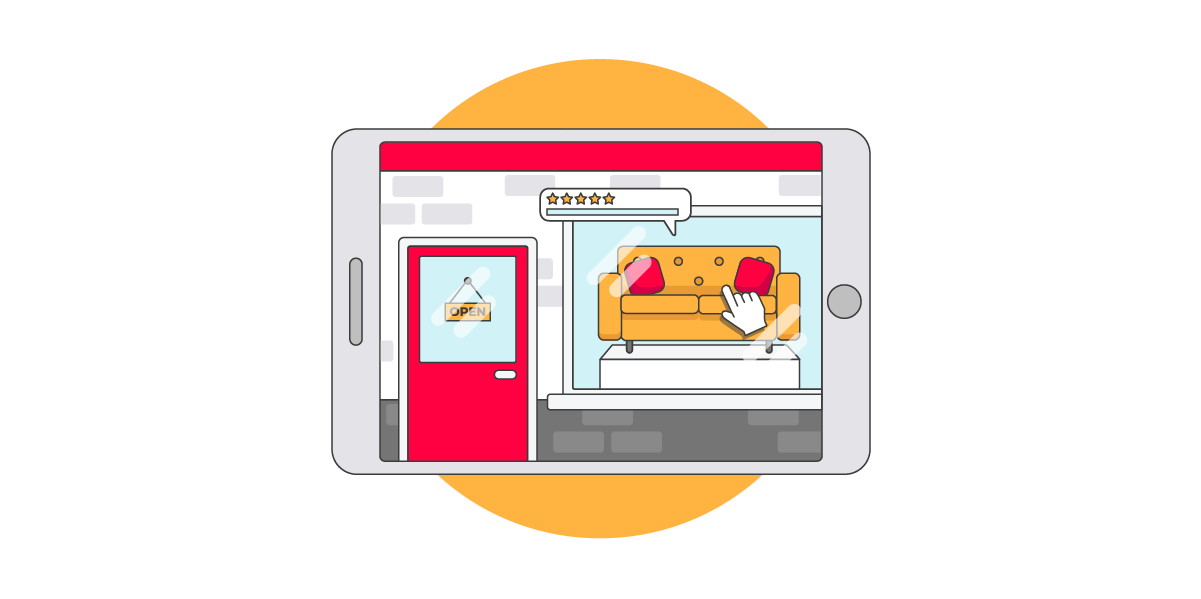
What exactly does “digital transformation” mean? Despite years of the term being bandied about and businesses pouring time, resources and planning into their transformations – particularly over the last 10 months – it’s a term that many would still struggle to define exactly. What should digital transformation look like for any given business?
In a presentation at Econsultancy Live 2020, ‘What brands really mean when they talk about ‘digital transformation’’, Summit Managing Director Martin Corcoran observed that, “In the news, a digital transformation seems to be … getting rid of your stores and your staff and your fixed costs and hiring people with either ‘digital’ or ‘transformation’ in their title, and if you do those two things, you are in a digital transformation.”
After comparing definitions of digital transformation from Gartner, Deloitte and Salesforce, Corcoran shared Summit’s very simple ethos when it comes to approaching digital transformation projects: ‘Do the stuff that customers love, online.’
“Replicate the brand experiences, the USPs of your business; replicate the stuff that customers really like that make you as a brand or retailer famous, and do them online,” said Corcoran. “You don’t need to invest millions in infrastructure and enterprise solutions and rework your ‘backend business model’; simply understand your customer.
“Do the stuff that customers love, online. If you do that, and you try to do more of it, you will transform your business digitally.”
But which retailers are walking the walk when it comes to translating what makes their brand unique into an online environment? Over the course of their presentation, Corcoran and Rebecca Wilkes, Senior Client Director at Summit, walked the audience through eight stand-out examples of retailers who, through their digital transformation, have demonstrated a strong understanding of what customers want from their brand and have found ways to recreate it online.
Join Summit this year for The Retail Reset webinar series and join discussions with other retailers and leading retail experts. Sign up here.
1. Aldi
Budget grocery brand Aldi has been relatively slow to move its offering into the digital sphere; it launched its first ecommerce offering in 2016, first selling wine and then expanding into electricals and other non-food items. It was only in the midst of the coronavirus crisis in 2020 that it ventured into selling groceries online, beginning with a ‘food box’ of essentials (the likes of which many other grocery brands were offering) and moving into a partnership with Deliveroo to sell groceries through its app, and finally launching a fully-fledged online grocery store with click-and-collect.
As a discount retailer, Aldi’s hesitation over moving into online makes sense – while there is a rapidly-growing opportunity in online groceries thanks to the Covid-19 pandemic, most supermarkets struggle to turn a profit with online channels. But now that Aldi has entered the online arena, it is finding ways to translate its most unique characteristics – the things customers love about it – into the digital experience.
“It is a bargain hunter’s treasure hunt,” said Corcoran of the experience of shopping with Aldi in-store. “You don’t actually know what you’re going to buy when you go in the store. I didn’t know I was going to buy some pink, fluffy welly boots for my daughter – I didn’t know I was going to buy a cordless power drill for myself. But I saw the products, saw the prices, got excited, and decided I didn’t want to miss out.”
Aldi has translated this “middle aisle” experience online by cheerfully jumbling its products together in a way that promotes unexpected finds, rather than opting for a store experience that emphasises search or neat categorisation. Granular product categories are present for those shoppers who are expecting a more traditional online shopping experience or are looking for something more specific, but lovers of the Aldi “bargain hunt” can simply meander through a category like Specialbuys – limited-edition products available at extremely low prices – and find the gems they never knew they needed.
“You can see the box storage next to the headphones, next to the boxing equipment, next to the beauty products,” said Corcoran. “They know customers come for that experience and that treasure hunt – whether you’re in-store or you’re online, they’ve done a fabulous job of recreating that experience.”
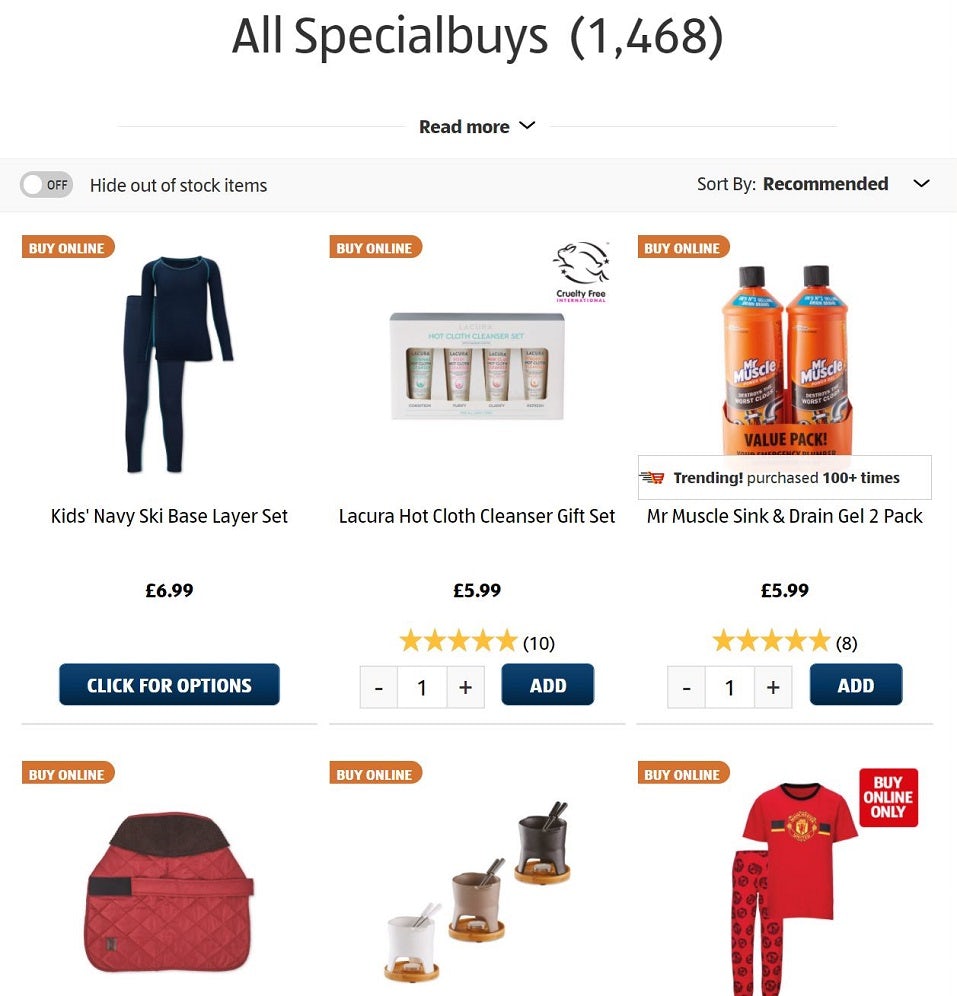
The Specialbuys section of Aldi’s ecommerce website offers a “classic” Aldi experience for online bargain hunters. (Image: Aldi)
2. Selfridges
A major focal point of the Selfridges in-store experience is its unique, elaborately-crafted window displays that drive footfall into stores and spark inspiration in shoppers passing by. These are a particular event at Christmas and are accompanied by Selfridges’ annual ‘Christmas Comes Early’ promotion that launches every November, offering discounts across a variety of product categories.
But with footfall dwindling to a fraction of its usual amount during the Covid-19 pandemic, Selfridges was forced to reinvent its approach to window displays. “They’ve had to really challenge themselves to think a bit differently, and think about how they can drive that awareness and engagement online,” said Rebecca Wilkes.
Over the holiday period, Selfridges created a dedicated online Christmas content hub that allowed consumers to virtually experience its window displays, accompanying each one with a paragraph of text explaining the inspirations and work that went into creating the displays.
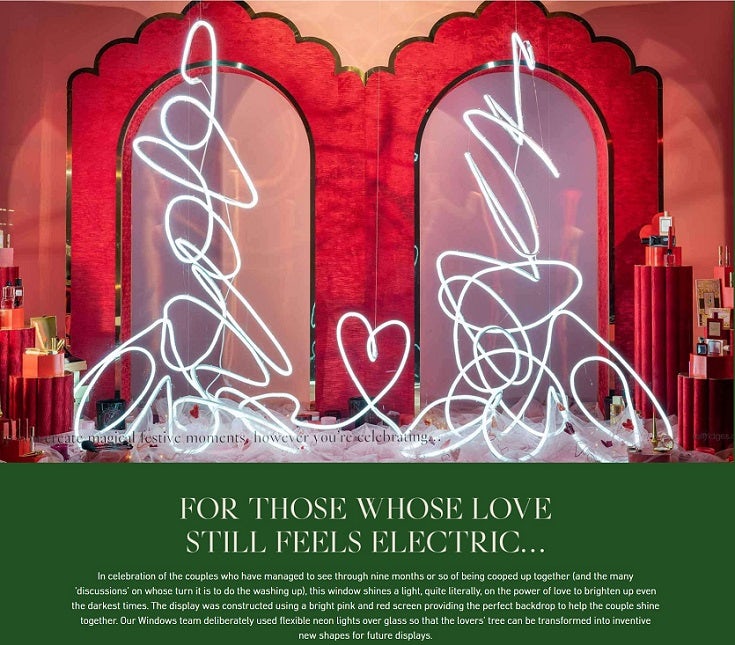
Selfridges created a virtual hub for its Christmas window displays for anyone who was unable to visit the Oxford Street flagship store in person during the Covid-19 pandemic. (Image: Selfridges)
Underneath each display was a scrollable gallery of products on the same theme – for example, cookware for a cookery-themed display, or toys for a toyshop-themed display – that shoppers could click on to visit the item’s product page and buy. “They focused on categorising those products in the way that you might potentially shop as you navigate through Selfridges – as the person you’re shopping for,” said Wilkes.
3. Pandora
A big draw of Pandora’s in-store experience for customers is its personalisation, with experts on-hand to guide you towards the right purchase and provide information about products, as well as the ability to try on products before buying them.
During the pandemic, the jewellery category has seen remarkable growth online, providing an opportunity for retailers like Pandora to be present in the consideration phase as consumers are buying jewellery. In lieu of the option to try on items in-store, Pandora has used augmented reality to create a ‘Virtual try on’ experience that lets customers visualise bracelets, rings and charms on their own hand.
Pandora has also brought the expertise of its in-store staff online with Live Advice, offered by its Style Assistants who use video chat to give customers advice on styling the jewellery pieces they are interested in and even show them products in-store. Short of being able to let customers physically touch and handle the items, Pandora has done an impressive job of replicating what makes its in-store experience unique using the virtual tools at its disposal.
4. Clarks
Clarks is another brand known and sought-after for its in-store experience: it has a reputation for high-quality, comfortable products, and also for the expertise of its store staff, particularly when it comes to fitting children’s shoes.
“We spoke to Clarks’ Finance Director, Andrew Stoodley, about this and he said how important the in-store experience was for Clarks for driving revenue,” said Wilkes. “This is another area that’s been really hit by the pandemic – people are feeling less comfortable about going into stores; less comfortable about that one-to-one interaction with assistants. Clarks really had to think about how to create that experience online and giving consumers that confidence that they’re buying a really great product.”
Clarks converted this in-store expertise into bespoke content and expert guides online, creating video content and partnering with influencers to explain how parents can accurately measure their children’s feet from the comfort of their own home. Clarks has even made its measuring gauges for toddlers and juniors, previously only used as part of in-store fittings, available to buy online to assist with home measurements.
To ensure it remains part of the consideration phase for parents who are searching for advice on how to measure their children’s feet, Clarks has invested in Product Listing Ads that will surface its shoe gauge for searches like ‘How to measure children’s shoe size’ or ‘measuring children’s shoe size’; its website content for how to measure at home also ranks highly for these searches.
“If somebody has read the guides, and they’ve used the shoe gauge, the likelihood is they’re probably going to end up buying that product through Clarks,” said Wilkes.
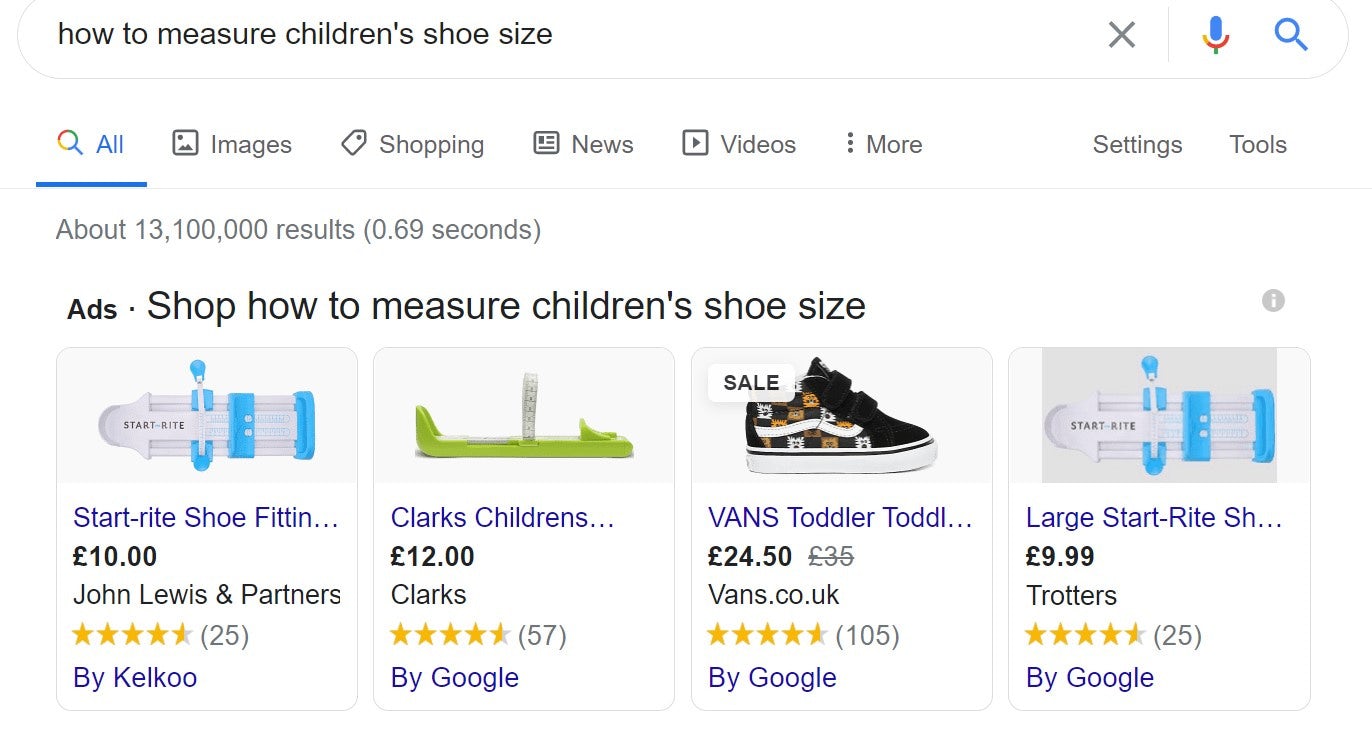 Clarks has invested in product listing ads (PLAs) to make sure that its shoe gauge product is surfaced for users searching for how to measure children’s shoe size.
Clarks has invested in product listing ads (PLAs) to make sure that its shoe gauge product is surfaced for users searching for how to measure children’s shoe size.
5. Argos
For decades, the Argos catalogue was a mainstay in British homes, with millions of consumers having a strong nostalgic attachment to the catalogue as a means of browsing for and picking out items to buy throughout their childhood and adulthood. As Wilkes put it, “Everybody can remember the role that the Argos catalogue played – circling birthday presents and Christmas gifts in the catalogue. It was the way to shop … At the height of its popularity, they were printing 10 million of these catalogues at any one time.”
An initial proposal to phase out the printed Argos catalogue in 2017, during which the catalogue was removed from some stores in order to “test demand” for the take-home edition, sparked widespread consumer outrage with some customers saying that they would even be willing to start paying a small amount for the famous catalogue. But 2020 finally sounded the death knell for the printed Argos catalogue after nearly 50 years, which will stop printing regularly at the end of January 2021.
“The reason for this is that consumers’ needs have changed. They no longer want to go into store and flick through that catalogue and write the number down and take it to the till – what they want to do is do that from the comfort of their own living room,” said Wilkes.
The feel of the Argos catalogue lives on in its online website, however, with the front page retaining that classic Argos look and using many of the same product categories, while at the same time offering the benefits of internal search and granular categorisation, filtering and sorting. Argos has paired this with “a full digital marketing strategy, including above-the-line activity, driving awareness with paid social and display, right through to conversion through PPC and PLAs.”
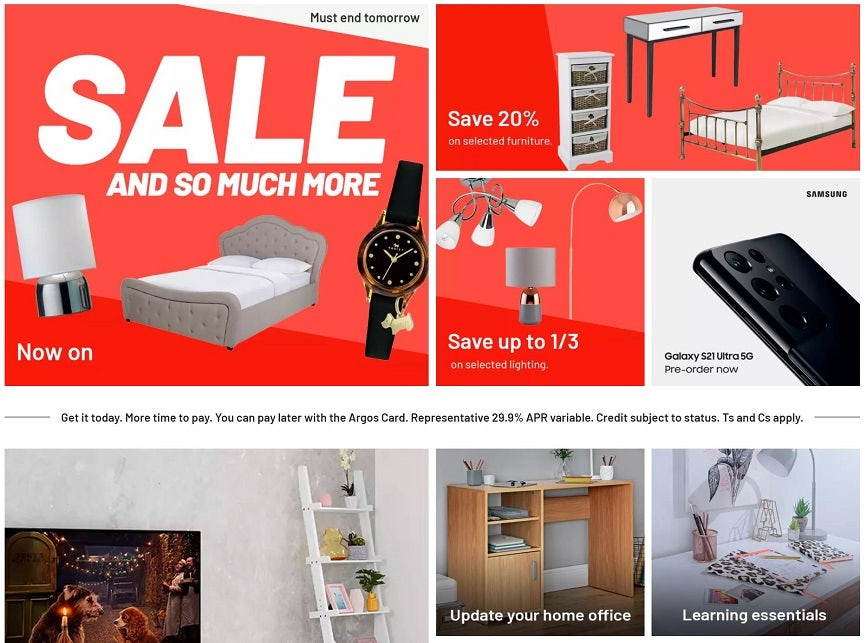
The front page of Argos’ website retains the look and feel of its beloved print catalogue while still offering the benefits of an online navigation experience. (Image: Argos)
6. Joules
‘Country living’ clothing brand Joules, which aims to combine functionality with style, got its start in 1989 when founder Tom Joule began selling clothing from a stand at a country show in Market Harborough, a Leicestershire market town. Joule built up the business through an intimate knowledge of his customers (many of whom he knew by name), their needs and preferences, which led to the development of a mail-order system and eventually a website.
Fast forward to the present, and Joules’ website now accounts for 70% of the business’s total sales. And in 2019, the brand launched Friends of Joules, a marketplace for small businesses that emulates the market town shopping experience online in a callback to Joules’ origin.
“They’ve really tapped into the necessity of online gifting and created this virtual marketplace,” said Wilkes. “You can go to different brands, and you can browse different products that Joules would never normally have had on their site, but they’ve got this now in place as a marketplace to really support that crafting and gifting community.”
7. H&M
Fashion is an especially competitive area of retail, and attracting a loyal customer base who return to shop with your brand is especially critical in fashion ecommerce, with trendy brands like Boohoo, Missguided and Asos giving longer-standing retailers a run for their money and forcing them to get creative in order to stand out.
H&M has made recycling and sustainability one of its cornerstones, and since 2013 has operated a Garment Collecting programme that allows consumers to hand in unwanted clothes from any brand in any condition and receive a £5/5€ voucher in return. This has the added benefit of encouraging store visits, which Wilkes pointed out is “great for the in-store customer, but not so great for the digital customer”.
However, in recent years H&M has also made its loyalty offering for online customers much more robust and enticing. Perks of its loyalty programme include a 10% discount upon joining, digital receipts, free click-and-collect, free standard delivery for orders of £20 or more, exclusive discounts and early access to selected collections, and much more – giving online customers many more reasons to return as well.
How to go about putting digital transformation into practice
Corcoran and Wilkes concluded their presentation with three actionable tips for retailers who are unsure where to begin with digital transformation.
1. Research the customer journey to prioritise key preference drivers
“Essentially, figure out what your customers like, and then try to do more of it,” said Corcoran. “Our first recommendation is that anyone who’s on a digital transformation journey takes a step back and prioritises the most important customer touchpoints in their journey. What are the reasons why customers pick your brand, buy from your brand, stay loyal to your brand?”
He emphasised the need to draw on multiple datasets, such as sales data, clickstream data, loyalty data and external data sources, both quantitative and qualitative, such as customer surveys and interviews.
2. Scorecard your digital proposition against competitors
“Scorecard is very much a Summit word and a Summit proposition – by that we mean audit,” said Corcoran. “We do that by asking a number of questions and surfacing data points like, ‘How close are you to your customers? How well do you surprise and delight them? How well do you engage your customers?’”
Summit’s ecommerce proposition scorecard involves a 289-point audit, across technology, online marketing, trading, logistics and services. They have conducted this audit on dozens of existing major brands including the likes of Asos, Argos, Next, M&S, New Look, Zara and more, ranking them from highest to lowest. Summit extended an offer to share historical scorecard data, or to share the 289 points that make up the ecommerce scorecard, with anyone tuning in to the presentation if they contacted scorecard@summitmedia.com.
3. Prove the value to convince your investors
“I think one of the most fundamental mistakes is – brands and retailers put lots of money and effort and time into doing certain things without the proof of concept, without the absolute confidence that whatever they roll out is going to work,” said Corcoran. “The beauty of digital is the access to the data and the speed to market – use it and make sure that you prove the value.”
Corcoran outlined this process in four steps: one, make a starting statement that is linked to customer benefits and business success. Two, use all available research to sketch out a Minimum Viable Product plan with achievable objectives and timeframes. Three, prototype the idea using trials and free-to-use tools plus existing resources and material to test readiness of the concept. And four, build your proof of concept (POC) cheaply and measure lots.
“A digital POC isn’t about the build,” said Corcoran. “It’s about saying, ‘Can I prove the value?’ You need to make sure you focus on results and on proving the value of your proof of concept.”
Join Summit this year for The Retail Reset webinar series and join discussions with other retailers and leading retail experts. Sign up here.

Comments